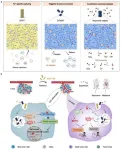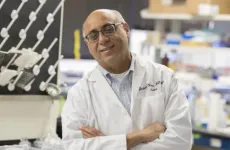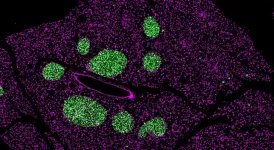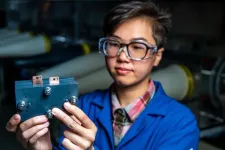(Press-News.org) The body regulates its metabolism precisely and continuously, with specialised cells in the pancreas constantly monitoring the amount of sugar in the blood, for example. When this blood sugar level increases after a meal, the body sets a signal cascade in motion in order to bring it back down.
In people suffering from diabetes, this regulatory mechanism no longer works exactly as it should. Those affected therefore have too much sugar in their blood and need to measure their blood sugar level and inject themselves with insulin in order to regulate it. This is a relatively imprecise approach compared to the body’s own mechanism.
Equipping cells with special functions
Martin Fussenegger is Professor of Biotechnology and Bioengineering at the Department of Biosystems Science and Engineering of ETH Zurich in Basel. With the above situation in mind, he and his team have been working on cell therapies for some time. One day, the hope is that these therapies will allow metabolic diseases such as diabetes to be treated individually and precisely – or even cured.
But how do these cell therapies work? First, the researchers modify human cells by incorporating a network of genes that give the cells special abilities. These cells are implanted under the skin, for example, and the network is activated by a specific external stimulus.
A suitable switch is key
To that end, the researchers have developed various types of switches over recent years. Some can be controlled electrically, others with light, and one even using music by the British rock band Queen (see ETH News).
The researchers in Basel have now developed another variant, which they have presented in the journal external page Nature Biomedical Engineering.
“For me, this solution is the best gene switch that my group and I have built so far,” says Fussenegger. The reason is that the switch can be triggered using the long-established active ingredient nitroglycerine, and that the means of application – sticking a patch to the skin – is very simple. Corresponding patches are already available to buy in various sizes in any pharmacy.
Nitroglycerine quickly diffuses out of the patch and into the skin, where it encounters an implant that contains modified human kidney cells.
Network activated by nitric oxide
These cells specifically intercept the nitroglycerine and have a built-in enzyme that converts it into nitric oxide (NO), a natural signalling molecule. In the body, NO normally causes blood vessels to dilate, leading to increased blood flow. It is broken down within a few seconds and therefore only affects a very localised area.
The implanted cells are modified so that NO triggers the production and release of the chemical messenger GLP-1, which in turn boosts insulin release by the beta cells of the pancreas and thus regulates blood sugar level. GLP-1 also triggers a feeling of satiety, thereby reducing food intake.
The new switch is made exclusively of human constituents – that is, it contains no components from other species. “That’s a new and groundbreaking feature,” says Fussenegger. With components from other species, there is always a risk of false triggering, interference with the body’s own processes, or immune reactions. “Here, we’re able to rule that out.”
A whole arsenal of switches
In the last 20 years, the ETH professor has developed various different gene switches, some of which respond to physical triggers such as current, sound waves or light. Which type has the best chance of being implemented one day?
“Physical triggers are interesting because we don’t need to use molecules that interfere with the body’s own processes,” the biotechnologist says. He explains that electrical signals are ideal for controlling switches and gene networks using portable electronics such as smartphones or smartwatches – and AI can then be incorporated, too. “I therefore think electrogenetic cell therapies have the best chances of implementation. In terms of chemical switches, I see the new solution as being in pole position,” says Fussenegger.
However, the further development of these cell therapies based on gene switches is a complex and lengthy process. “Developing a cell therapy to market maturity not only takes decades but also requires lots of staff and sufficient resources,” says the researcher. “There’s no shortcut.”
Until now, Fussenegger’s work has focused mainly on cell therapies for diabetes, which is one of the world’s most prevalent metabolic diseases, affecting one in ten people. “That’s the model disease we work with. Fundamentally, however, it’s also possible to develop cell therapies for other metabolic, autoimmune or even neurodegenerative diseases – in principle, for everything that requires dynamic regulation.” According to Fussenegger, many drugs are like a hammer that is used to strike at a problem blindly. “Cell therapies, on the other hand, solve the problem in a similar way to the body,” he says.
END
A new switch for the cell therapies of the future
2025-02-14
ELSE PRESS RELEASES FROM THIS DATE:
Utilizing a nanomedicine to achieve tumor catalysis-enhanced differentiation therapy
2025-02-14
Tumor metastasis, recurrence, and therapeutic resistance are the main reasons for the failure of clinical cancer treatment. Studies have found that the presence of cancer stem-like cells (CSCs) with stemness characteristics in malignant tumors is a key factor leading to the above undesirable results. However, there are significant limitations to current strategies with traditional molecular drugs for combating CSCs, such as the unsatisfactory in vivo stemness-suppressing efficiency, and the lack of powerful tumor-specific lethal action, resulting in remaining massive bulk tumor cells that can convert to CSCs via epithelial-to-mesenchymal ...
Report documents the devastation of the ancient city of Palmyra, a World Heritage Site, after the fall of the Assad regime
2025-02-14
Palmyra is one of the most famous sites in Syria for its extraordinary heritage and archaeological remains. Inscribed on the World Heritage List in 1980, the city saw much of its heritage destroyed during the war. Following the liberation of Syria from the Assad regime on 8 December, a multidisciplinary team has carried out a field study in Palmyra to assess the current state of the archaeological monuments and the surrounding residential areas, comparing them with their condition before the start of the Syrian uprising in 2011. The report is an initiative of Palmyrene Voices of the NGO Heritage for Peace in collaboration with the CSIC's Milà i Fontanals Institution.
‘We ...
Major trial to determine if ketamine can stop deadly epilepsy seizures
2025-02-14
University of Virginia Brain Institute and School of Medicine researchers have received an initial $9.3 million award from the National Institutes of Health for a $30 million clinical trial to determine if the powerful anesthetic ketamine can save patients from prolonged, life-threatening grand mal seizures that won’t respond to other treatments.
“Status epilepticus,” as the seizures are known, are seizures that last more than five minutes or that strike repeatedly without the ...
INSEAD Webinar to explore the future of agentic AI & autonomous organizations
2025-02-14
Digital@INSEAD is hosting a free TECH TALK X webinar, “The Future of Agentic AI & Autonomous Organizations” on Thursday, 27 February 2025 at 9.00 am ET / 3.00 pm CET (60 min).
AI is evolving beyond tools and assistants – it is becoming autonomous. But what is holding enterprises back from fully leveraging Agentic AI?
Join in the free webinar for a deep dive with Rotem Alaluf, CEO of Wand – a pioneering platform for enterprise-grade AI systems – and Peter Zemsky, ...
Climate change threatens global cocoa production: New study highlights pollination-based solutions
2025-02-14
Cocoa (Theobroma cacao L.) is a vital cash-crop for four to six million small-holder farmers across the tropics, and supports a global chocolate industry valued at over USD 100 billion annually. The combination of millions of farmers relying on cocoa for their livelihoods, and increasing global demand for the crop, has driven cocoa plantation expansion and intensification of farming practices, often at the expense of biodiversity and long-term sustainability.
A new research study led by the University ...
Mouse study finds impaired cell development: Intermittent fasting could be unsafe for teenagers
2025-02-14
A recent study reveals that age plays a significant role in the outcomes of intermittent fasting. Researchers from Technical University of Munich (TUM), LMU Hospital Munich, and Helmholtz Munich discovered that chronic intermittent fasting disrupted the development of insulin-producing beta cells in young mice. The findings raise concerns about potential risks for humans, especially teenagers.
“Intermittent fasting is known to have benefits, including boosting metabolism and helping with ...
From collisions to stellar cannibalism – the surprising diversity of exploding white dwarfs
2025-02-14
Astrophysicists have unearthed a surprising diversity in the ways in which white dwarf stars explode in deep space after assessing almost 4,000 such events captured in detail by a next-gen astronomical sky survey. Their findings may help us more accurately measure distances in the Universe and further our knowledge of “dark energy”.
The dramatic explosions of white dwarf stars at the ends of their lives have for decades played a pivotal role in the study of dark energy – the mysterious force responsible for the accelerating expansion of the Universe. They also provide the origin of many elements in our ...
World Pangolin Day celebrated with new genomes to aid the world’s most trafficked animal
2025-02-14
Pangolins are unique as they are the only mammal to be covered in scales. Even though they are scaly, photos of them are typically met with “awwws” from the viewers who find them adorable. Importantly, though, pangolins play an essential role in maintaining their ecosystem. Their other “unique trait” is that they are the most trafficked wild animal in the world, with more than 900,000 poached in the past two decades. Much of this is due to their high value for use in traditional medicine that ...
Dangerous bacteria lurk in hospital sink drains, despite rigorous cleaning
2025-02-14
We hope to be cured when we stay in hospital. But too often, we acquire new infections there. Such ‘healthcare-associated infections’ (HAI) are a growing problem worldwide, taking up an estimated 6% of global hospital budgets. In the EU alone, HAIs add up to more than 3.5 million cases per year, resulting in 2.5 million disability-adjusted life years, a cost of up to €24 billion, and 90,000 deaths. They are likewise the sixth leading cause of death in the US.
Patients with lowered immune defenses, and in some hospitals, ...
Mini flow battery speeds energy storage research
2025-02-14
RICHLAND, Wash.—Sometimes, in order to go big, you first have to go small. That’s what researchers at the Department of Energy’s Pacific Northwest National Laboratory have done with their latest innovation in energy storage.
With a goal to speed the time to discovery of new grid energy storage technology, the team designed a compact, high-efficiency flow battery test system that requires an order of magnitude less starting material while delivering results equal to the standard lab-scale ...







